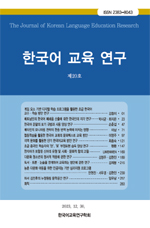본 논문의 목적은 베트남인 한국어 학습자들의 한국어 폐쇄음 산출음에 대한 한국인의 지각 양상을 알아보는 데 있다. 이를 위해 베트남인의 한국어 폐쇄음 산출음에 대한 한국인의 지각 실험을 진행하였다. 실험 결과는 제시음이 어두에 위치할 경우 ‘/ㅌ/(89%) > /ㅋ/(88%) > /ㅍ/=/ㅂ/(84%) > /ㄱ/=/ㄸ/(74%) > /ㄷ/(72%) > /ㅃ/(65%) > /ㄲ/(61%)’ 순으로 나타났고, 어중 초성의 경우 ‘/ㅍ/=/ㅋ/(91%) > /ㅌ/(88%) > /ㄷ/(68%) > /ㅂ/(61%) > /ㄸ/(60%) > /ㄲ/(51%) > /ㅃ/(46%) > /ㄱ/(40%)’의 정답률을 보였다. 어두에서 /ㄸ/, 어중에서 /ㄱ/의 경우를 제외하고는 어두와 어중 모두에서 격음 > 평음 > 경음 순으로 정확도가 높게 나타났다. 어두에서의 정답률이 어중 환경에서의 정답률보다 높게 나타났으며 이는 행렬 분석을 통해 더욱 명확하게 드러났다. 어두· 어중 환경에서 공히 제시음이 ‘평음’일 때는 ‘경음’, ‘경음’일 때는 ‘격음’, ‘격음’일 때는 ‘평음’과 혼동하는 양상을 보였다. 결합 모음별 정답률을 보면 어중 평음(/ㅣ/ > /ㅜ/ > /ㅏ/)을 제외하고 다른 모든 경우에서는 /ㅣ/ > /ㅏ/ > /ㅜ/의 순서로 정답률이 높았다. 이 결과는 결합모음이 전설 모음에서 후설 모음으로 갈수록 정답률이 떨어지고 있음을 보여주고 있다.
The purpose of this paper is to investigate the perception patterns of Koreans regarding the production of Korean stop consonants by Vietnamese Korean language learners. For this purpose, an experiment was conducted on Koreans' perception of Vietnamese learners’ production of Korean stop consonants. The results of the experiment show that when the presentation sound is located at the beginning of the word, the correct answer rate was ‘/ㅌ/ 89%) > /ㅋ/(88%) > /ㅍ/=/ㅂ/(84%) > /ㄱ/=/ㄸ/(74%) ) > /ㄷ/(72%) > /ㅃ/(65%) > /ㄲ/(61%)', and in the case of word-medial onset consonants, ’/ㅍ/, /ㅋ/(91%) > /ㅌ /(88%) > /ㄷ/(68%) > /ㅂ/(61%) > /ㄸ/(60%) > /ㄲ/(51%) > /ㅃ/(46%) > /ㄱ/(40%)’. Except for the case of /ㄸ/ in word-initial and /ㄱ/ in word-medial, accuracy was found to be high in the order of aspirated consonants > plain consonants > tense consonants for both word-initial and word-medial positions. The percentage of correct responses in the word-initial environment was higher than that in the word-medial environment, and this was revealed more clearly through matrix analysis. In both word-initial and word-medial environments, when the target sound was ‘plain’, it was confused with ‘tense’, when it was ‘tense’ it was confused with ‘aspirated’, and when it was ‘aspirated’ it was confused with ‘plain’. Looking at the correct rate for each following vowel, except for the word-medial plain consonant (/ㅣ/ > /ㅜ/ > /ㅏ/), in all other cases, the correct rate was high in the order of /ㅣ/ > /ㅏ/ > /ㅜ/. This result shows that the correct response rate for the following vowels decreases as the vowels move from the front vowels to the back vowels.
1. 서론
2. 실험
3. 분석
4. 논의 및 결론
참고문헌
(0)
(0)
